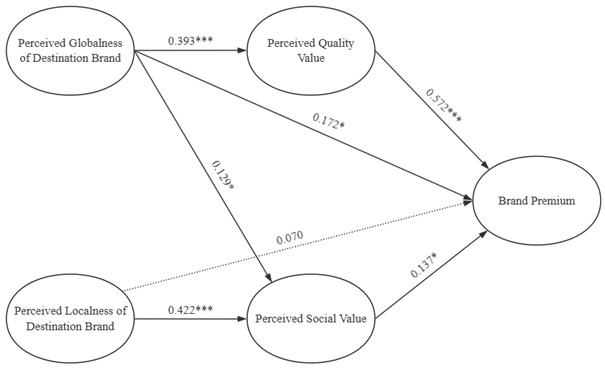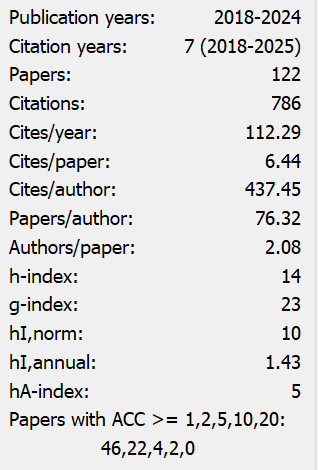The Impact of Destination Brand Globalization and Localization on Brand Premium — A Case Study of Global Theme Parks
Abstract
Based on signaling theory, this study introduces global brand research into the tourism field to explore the underlying mechanisms through which perceived globalness and perceived localness of destination brands influence brand premium. Empirical results show that perceived globalness of a brand can directly and positively affect brand premium, as well as indirectly influence brand premium through perceived quality value and social value. In contrast, perceived localness only affects brand premium indirectly through perceived social value.
References
[2] Milman, A. (1993). Theme parks and attractions. VNR’s Encyclopedia of Hospitality and Tourism, 934.
[3] Brown, J., & Church, A. (1987). Theme parks in Europe. Riding High in the 1980s.
[4] Alden, D. L., Steenkamp, J.-B. E., & Batra, R. (1999). Brand positioning through advertising in Asia, North America, and Europe: The role of global consumer culture. Journal of Marketing, 63(1), 75–87. https://doi.org/10.2307/1252002
[5] Steenkamp, J.-B. E. M., Batra, R., & Alden, D. L. (2003). How perceived brand globalness creates brand value. Journal of International Business Studies, 34, 53–65.
[6] Özsomer, A. (2012). The interplay between global and local brands: A closer look at perceived brand globalness and local iconness. Journal of International Marketing, 20(2), 72–95.
[7] Kayak, M., & Simoni, M. (2016). Revisiting tourist behavior via destination brand worldness. Management Science Letters, 6(11), 671–680.
[8] Luo, J., Dey, B. L., Yalkin, C., Sivarajah, U., Punjaisri, K., Huang, Y.-A., & Yen, D. A. (2020). Millennial Chinese consumers' perceived destination brand value. Journal of Business Research, 116, 655–665.
[9] Sokołowska, E., Pawlak, K., Hajduk, G., & Dziadkiewicz, A. (2022). City brand equity, a marketing perspective. Cities, 130, 103936.
[10] Wang, S., Japutra, A., & Molinillo, S. (2021). Branded premiums in tourism destination promotion. Tourism Review, 76(5), 1001–1012.
[11] Qibo, H., Zhijing, F., & Chunyang, W. (2021). Influence of brand personality on tourism destination brand premium. Economic Geography, 41(9), 232–239.
[12] He, J. (2006). The differences of brand equity between local companies and foreign companies: A positive study based on CBRQ scale. China Industrial Economy, 8, 109–116.
[13] Cronin, J. J., Jr., Brady, M. K., & Hult, G. T. M. (2000). Assessing the effects of quality, value, and customer satisfaction on consumer behavioral intentions in service environments. Journal of Retailing, 76(2), 193–218.
[14] Walsh, G., Shiu, E., & Hassan, L. M. (2014). Replicating, validating, and reducing the length of the consumer perceived value scale. Journal of Business Research, 67(3), 260–267.
[15] Chu, S., & Keh, H. T. (2006). Brand value creation: Analysis of the Interbrand-Business Week brand value rankings. Marketing Letters, 17, 323–331.
[16] Aaker, D. A., & Equity, M. B. (1991). The free press. New York, 206.
[17] Holbrook, M. B. (1999). Consumer value. A framework for analysis and research, 91–97.
[18] Gallarza, M. G., & Saura, I. G. (2006). Value dimensions, perceived value, satisfaction and loyalty: An investigation of university students’ travel behaviour. Tourism Management, 27(3), 437–452.
[19] Broyles, S. A., Schumann, D. W., & Leingpibul, T. (2009). Examining brand equity antecedent/consequence relationships. Journal of Marketing Theory and Practice, 17(2), 145–162.
[20] Hankinson, G. (2004). Relational network brands: Towards a conceptual model of place brands. Journal of Vacation Marketing, 10(2), 109–121.
[21] Zeithaml, V. A. (1988). Consumer perceptions of price, quality, and value: A means-end model and synthesis of evidence. Journal of Marketing, 52(3), 2–22.
[22] Kim, J.-H. (2014). The antecedents of memorable tourism experiences: The development of a scale to measure the destination attributes associated with memorable experiences. Tourism Management, 44, 34–45.
[23] Sheth, J. N., Newman, B. I., & Gross, B. L. (1991). Why we buy what we buy: A theory of consumption values. Journal of Business Research, 22(2), 159–170.
[24] Park, H. J., & Rabolt, N. J. (2009). Cultural value, consumption value, and global brand image: A cross‐national study. Psychology & Marketing, 26(8), 714–735.
[25] Williams, P., & Soutar, G. N. (2009). Value, satisfaction and behavioral intentions in an adventure tourism context. Annals of Tourism Research, 36(3), 413–438.
[26] Sweeney, J. C., & Soutar, G. N. (2001). Consumer perceived value: The development of a multiple item scale. Journal of Retailing, 77(2), 203–220.
[27] Tsai, S.-P. (2005). Utility, cultural symbolism and emotion: A comprehensive model of brand purchase value. International Journal of Research in Marketing, 22(3), 277–291.
[28] Vázquez, R., Del Rio, A. B., & Iglesias, V. (2002). Consumer-based brand equity: Development and validation of a measurement instrument. Journal of Marketing Management, 18(1–2), 27–48.
[29] Netemeyer, R. G., Krishnan, B., Pullig, C., Wang, G., Yagci, M., Dean, D., Ricks, J., & Wirth, F. (2004). Developing and validating measures of facets of customer-based brand equity. Journal of Business Research, 57(2), 209–224.


This work is licensed under a Creative Commons Attribution 4.0 International License.
Copyright for this article is retained by the author(s), with first publication rights granted to the journal.
This is an open-access article distributed under the terms and conditions of the Creative Commons Attribution license (http://creativecommons.org/licenses/by/4.0/).


























